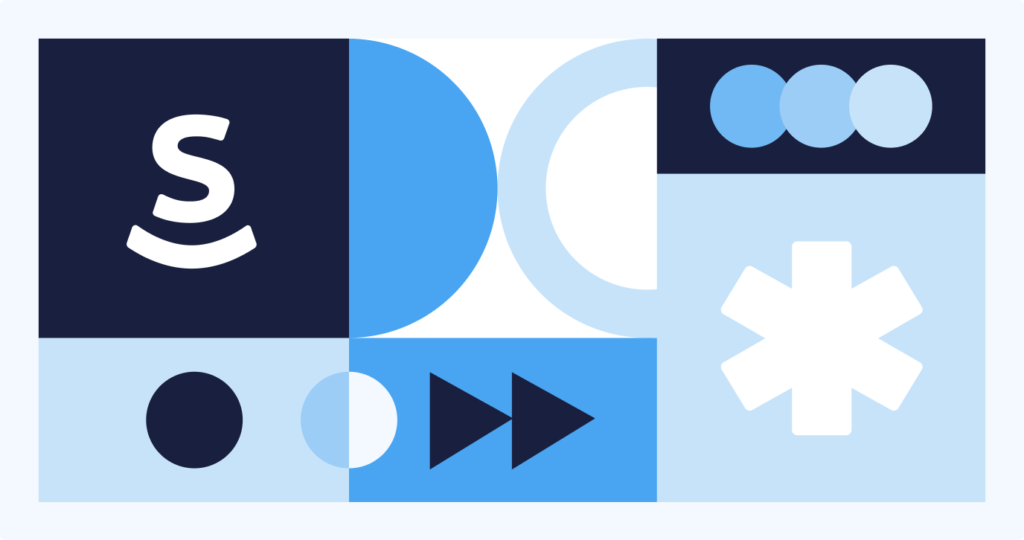
How do you automate health care?
Efficient workflows in healthcare organizations require the use of automation to streamline tasks like appointments scheduling, medical records updates, generating reports, and more. Automation technology provides many benefits to the healthcare industry, including increased efficiency for healthcare providers, better patient care outcomes, and lower costs for patients. Here are the 5 examples of health care workflows you can automate:
- Appointments scheduling and management
- Insurance pre-authorization
- Medical coding and billing
- Insurance claims processing
- Revenue cycle management
The prerequisites of healthcare digitisation
While rates of COVID-19 infection may be declining, winter will eventually return and that will raise new concerns within the healthcare industry for keeping it at bay. However, beyond diseases and rates of infection, medical organizations have to address issues such as excessive paperwork, which consumes doctors’ time, data errors, missed appointments, and other small complications that affect the quality of patient care.
Within the past year, the demand for digital healthcare solutions and services has increased dramatically (e.g., in certain European countries, healthcare automation demand multiplied by a factor of 30). Meanwhile, the level of job resignations among healthcare workers increased by 35% because of the excessive pressure on the medical industry. Beyond this, medical workers were the first for whom a COVID-19 vaccine mandate became a necessity.
In this blog, we’ll dive deeper into the topic of document automation in the healthcare industry, why it is of critical importance in the upcoming year, and how your medical organization will benefit from implementing workflow automation.
So what’s wrong with paper-based hospital workflow processes?
When comparing an old-fashioned approach to a modern solution, paper-based workflows prove to be inefficient, time-consuming, and prone to error. The COVID-19 pandemic shined a light on the inadequacies of our paper-based medical industry.
Healthcare automation statistics 2022
Take a look at a few statistics that highlight the necessity of implementing healthcare workflow management solutions:
- Before COVID, medical errors cost more than $20 billion and over 100,000 patient lives every year. Mixed-up tests, erroneous appointments, unsigned documents — all this can ruin a company’s reputation. During the pandemic, errors only compounded as 44% of healthcare workers were unable to handle electronic health record systems due to inadequate training for using technology at work.
- At the beginning of 2020, 50% of physicians suffered from burnout, primarily due to a load of non-clinical tasks (e.g., reporting, billing, document management, etc.). With the COVID-19 outbreak, the stress levels among medical workers increased by almost 11% and the burnout rate by 13%.
- Before the pandemic, 32% of healthcare workers used to spend over 20 hours per week on administrative tasks. Since 2020, with the exponential growth of patients and the number of documents to be processed, not only has the number of hours increased but physicians state that 38% of the paper-based administrative work is unnecessary.
According to McKinsey analysts, about 50% of the current healthcare activities will be fully automated by 2055 with the vast majority of them being paper-based processes.
So, how to improve workflow in healthcare organizations? When looking for an adequate solution, hospitals face many obstacles. The cornerstones of efficiency for the healthcare industry are streamlined workflows, compliance with the regulations, and patient care. Doubts still exist about whether automation can cover all these needs and facilitate hospital workflow processes rather than hinder them and waste an organization’s resources.
Benefits of implementing automated workflow in healthcare organizations
Enhanced patient experience
Waiting for hours, days, or even weeks until you get your doctor’s appointment can be frustrating, especially during a pandemic. Other than promptness, patient satisfaction depends on the attention and care they receive from healthcare organization staff, as well as how easy/difficult it is to schedule an appointment.
By automating medical document workflows, healthcare workers and patients get a win-win solution because:
- automatic document processing frees up administrative time on in-person communication with patients to make them feel more comfortable and cared for;
- automation in healthcare streamlines document workflows, which significantly reduces the waiting time for patients.
Improved medical establishment productivity
Clerical, repetitive tasks are intrinsically linked to every healthcare establishment’s daily routine. This is one of the main reasons for the level of healthcare worker fatigue and low employee morale, which currently stands at 52% increasing year over year. Luckily, the majority of these tasks do not require human involvement.
With a reliable automation solution, it only takes a few minutes to set up automated hospital workflow processes to:
- collect patient data (patient intake forms, medical history documents, hospital discharge forms, etc.);
- securely sign sensitive medical documentation with legally-binding eSignature;
- sort and store the collected documents for quick and convenient access;
- transfer data between patient forms and administrative documents, spreadsheets, etc.
Data confidentiality and security
Paper documents have no security guarantee unless they are safely locked. Stanford University research claims that 88% of data breaches are caused by employee mistakes (Cisomag, 2020).
With a reliable healthcare workflow automation solution, document access permissions are easily configured to allow or restrict users from editing or even viewing certain documents. Certain healthcare automation solutions also allow admins to assign roles that grant specific access permissions, not only for a certain workflow but within an organization in general. A reliable software solution for healthcare automation should be HIPAA-ready to ensure a sufficient level of patient data protection.
Detailed workflow analytics
With paper-based healthcare workflows, tracking the editing history within documents is nearly impossible. Even with digital documents, if they are sent the old-fashioned way (e.g., via email), it’s unlikely you’ll be able to track who opened a document and viewed its contents. Workflow automation software addresses this challenge with analytics tools.
For example, a healthcare automation solution allows for tracking:
- Who opened a document, when, and how many times
- Who made changes to a document (with detailed information about these changes)
- Which automatic actions (data transfers, document archiving, etc.) were performed successfully and which were not.
Just to name a few.
Reduced risk of errors
Statistics show that approximately 86% of errors in medical organizations are administrative and primarily caused by manual healthcare workflow management.
In the healthcare industry, even the slightest error can result in loss of life. One small inaccuracy in a medical record can have unintended and sometimes tragic consequences. Automation software is aimed at eliminating such errors.
To prove this point, here’s what a diagnostic solutions provider — T2 Biosystems — had to say about using the airSlate workflow automation solution for their document processes.
“airSlate’s ability to seamlessly integrate with Salesforce allowed us to easily disseminate important forms to end-users. The flexibility of airSlate allowed us to design a workflow that works for us. The automation built into airSlate helped us remove many manual steps in our old process.”
Anthony Matero,
Operations at T2 Biosystems
Discover the entire story of T2’s successful automation implementation in the airSlate blog.
What is healthcare administration?
Like in any other industry, administration in healthcare deals with managing healthcare workflows within a medical establishment.
According to the Bureau of Labor Statistics, the demand for healthcare administration workers between 2018 and 2028 is expected to increase by 18%.
The list of key responsibilities medical administration has to fulfill includes managing:
- Patient documentation
- Surgical equipment and inventory
- Performance reports and budget expenses
- Treatment protocols
- Rules and policy implementation
- HR processes
- Communication
In order to help medical administrative workers manage all of the above-mentioned responsibilities, electronic health record systems are now readily available.
Electronic Health Record software enables healthcare providers to create and effectively manage patient medical data as well as share it with any authorized parties (e.g., other healthcare providers).
In a nutshell, the components of an EHR are as follows:
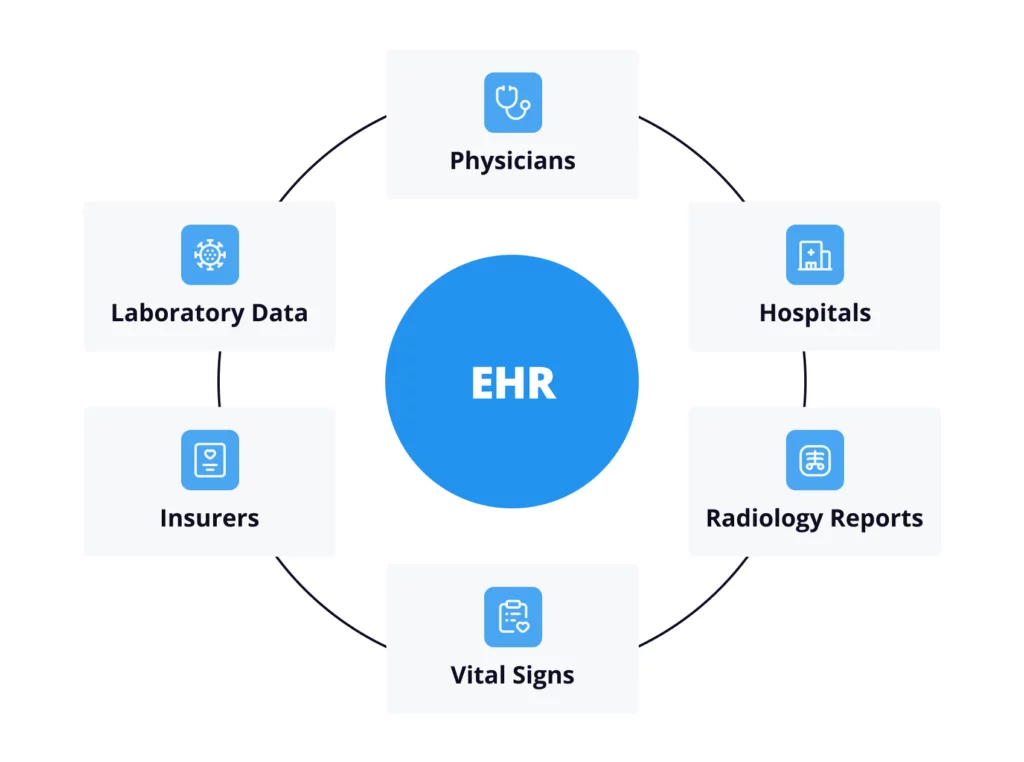
Though the first EHR system dates back to the 1960s, it wasn’t until the beginning of the 21st century that they experienced significant growth and demand in the healthcare industry worldwide.
With the rapid development of information technology, electronic health record software has become a must-have for any medical organization to maintain a competitive level of patient service.
The following chart displays the global growth rate of EHR applications in various medical processes:
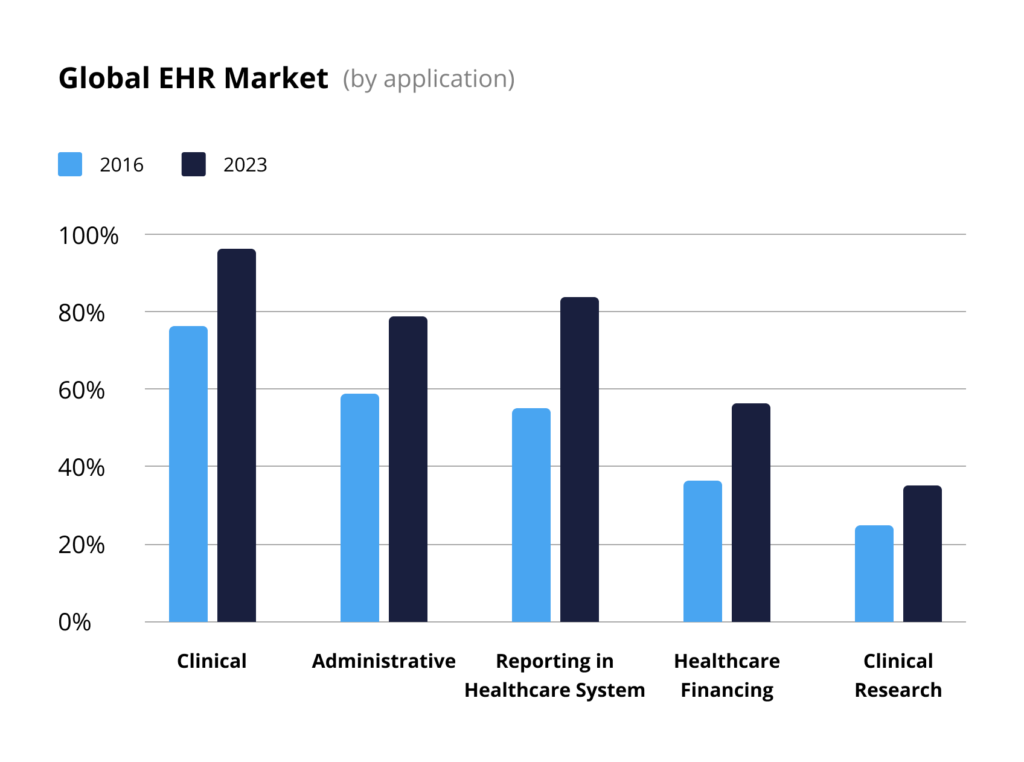
However, data digitization alone is not enough to address all the challenges medical administrators face with their daily healthcare operations. This is where automation comes into play.
Healthcare administration automation implies freeing up medical workers’ time for more valuable and important tasks by automating repetitive, routine operations. In this blog, we’re focusing more on document workflow automation since it’s the main “black hole” that consumes the majority of healthcare administration hours.
How are automated hospital workflow processes changing the healthcare industry?
Healthcare workflows range from patient consent forms and blood donor registration to infection control plans and others. We’ve selected the most-used medical workflow, Patient Intake, as an example to demonstrate the practical application benefits of automation in healthcare.
As a rule, the process of patient registration is the first experience and impression a person has of a healthcare establishment. That’s why it’s so critical that this workflow be conducted as quickly and smoothly as possible.
With the airSlate workflow automation solution, it only takes you a couple of minutes to set up a fully automated Patient Intake workflow.
1. Documents
You can add any document(s) you need for this healthcare workflow from your device/cloud storage, create them from scratch, or access the rich library of airSlate document templates.
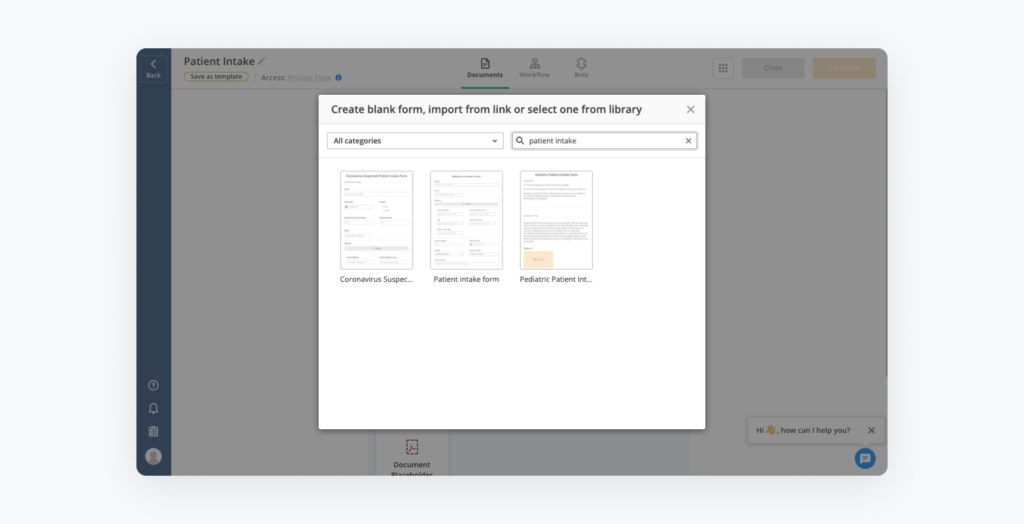
The user-friendly interface makes it easy to edit web forms and other documents to make them clear and understandable for patients and healthcare workers to complete.
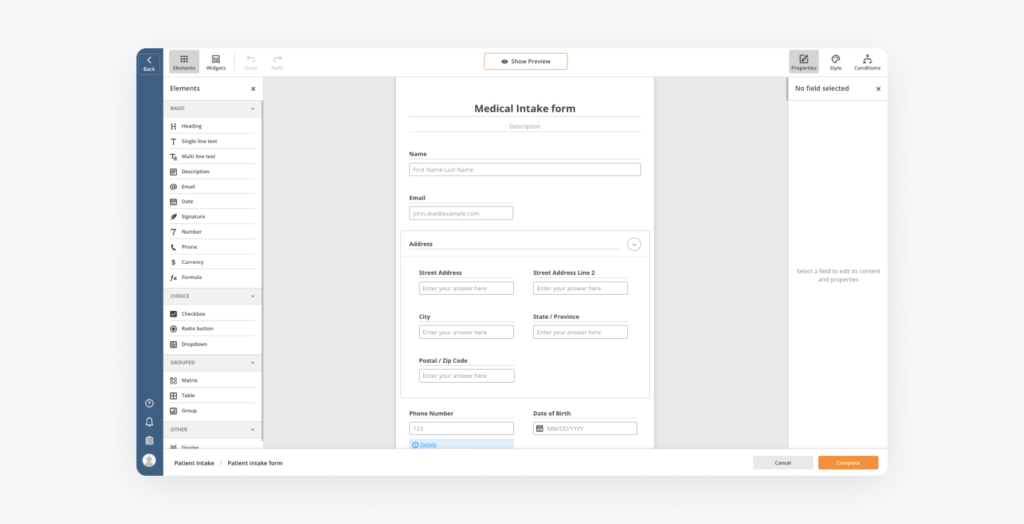
2. Workflow visualization
One of the most beneficial features of airSlate is the drag and drop diagram that allows users to build a visual representation of their healthcare process. You can add as many steps as you need and assign documents and access permissions to them. Doing so allows you to clearly see how the documents are routed between the healthcare workflow participants.
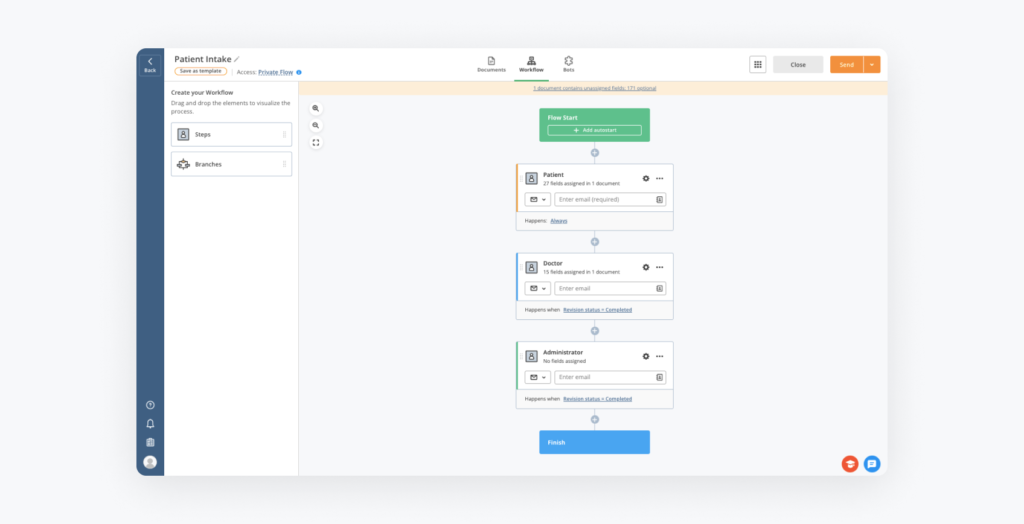
3. Workflow automation (Bots)
The airSlate drag-and-drop diagram already allows you to set up automatic document routing. Yet, if you want to automate other routine repetitive tasks that don’t require human involvement, airSlate Bots are here to help.
Send out automatic notifications and reminders, automate integration with external services (e.g., CRM systems, cloud storage services) for transferring data, making updates, saving changes, and so on. with user-friendly no-code Bots.
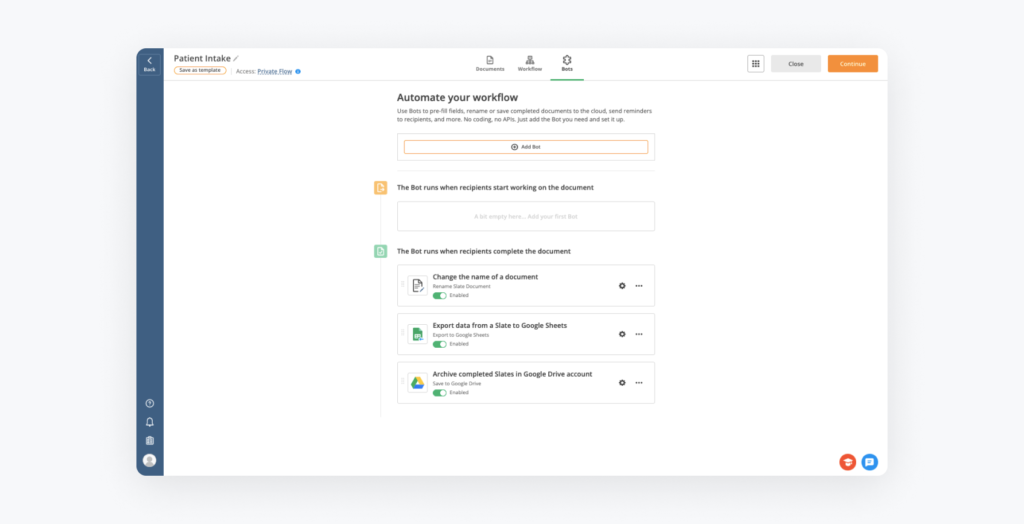
To learn how to set up a more detailed Patient Intake workflow, sign up for the dedicated airSlate Academy course.
Beyond Patient Intake, the airSlate Flow library contains dozens of templates for healthcare workflows, including those related to Covid-19. Find instructions for automating the three most popular medical workflows in our blog — Healthcare automation: 3 airSlate Flows for hospitals and medical institutions.
Healthcare automation trends 2022
Digital technologies have been actively transforming healthcare operations management industry-wide. The most recent research shows that this trend is likely to continue in 2022.
According to the HIMSS Future of Healthcare Report, about 80% of healthcare providers are planning to significantly increase their investments in digital solutions for healthcare services within the next five years.
The most common upcoming trends for medical automation include:
1. Digitized healthcare
This implies wider digitization of the healthcare environment with things like digital health records, medical data integration between systems, etc. Facilitating greater remote access to healthcare as well as connecting and keeping track of relevant patient information will no longer be a challenge for automated health systems. Digitizing and automating healthcare services was largely accelerated by COVID-19 and will become a must for a medical establishment to remain competitive.
2. Datafication, AI, and RPA in healthcare
Medical data transmitted by modern smart devices is the main driver in the push towards more proactive and personalized medicine. Meanwhile, AI usage is already growing in applications such as chatbots for gathering information and directing inquiries to the right healthcare professionals. AI and RPA spot patterns across enormous datasets much sooner and more efficiently than traditional analytics tools, resulting in better patient outcomes.
3. Higher standards for patient service
With the increasing application of technologies discussed in the previous two paragraphs, the majority of medical document workflows will be delegated to automation software. As a result, healthcare workers will be able to devote most of their time, attention, and care to patients.
To round out the topic, here’s a bit of data to compare healthcare automation predictions for 2022 with recent research by Zebra Technologies and Deloitte.
| Healthcare organizations in 2017 | Healthcare organizations in 2022 | |
|---|---|---|
| Electronic health record notification usage | 52% | 98% |
| Remote patient monitoring and health information tracking | 33% | 97% |
| Mobile device usage for healthcare automation | 51% | 98% |
In addition, with the advancement of digital technologies and medical automation, patients are becoming active participants in their own healthcare. In 2022, the percentage of patients using wearables to track health metrics is expected to increase to 57%, with 95% of them willing to share this data with hospital clinicians.
The bottom line
Healthcare digitization and automation is no longer a theoretical future but a current reality. With modern no-code solutions, like airSlate, delivering automation into the systems of medical organizations, fast, hassle-free, fully-automated, and HIPAA-compliant workflows can be created by healthcare workers in a matter of minutes.
Editor’s Note: This post was originally published on January 2, 2020 and was revamped and updated on April 28, 2022 for accuracy and comprehensiveness.
FAQ
- How do you automate health care?
- So what’s wrong with paper-based hospital workflow processes?
- Benefits of implementing automated workflow in healthcare organizations
- What is healthcare administration?
- How are automated hospital workflow processes changing the healthcare industry?
- Healthcare automation trends 2022
- The bottom line

